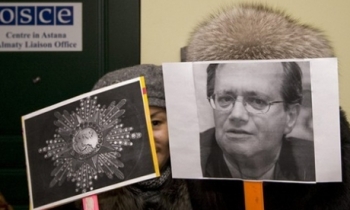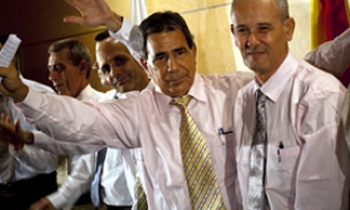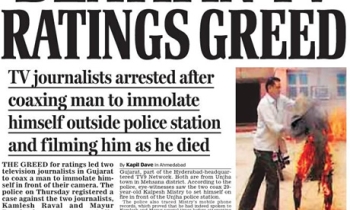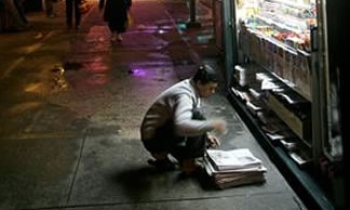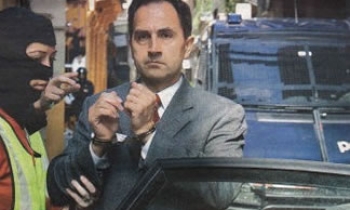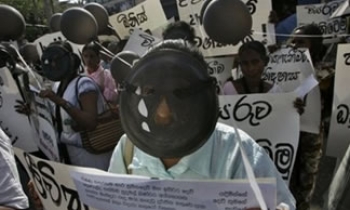Carlos Sanchez and his newsroom at the Waco (Texas) Tribune-Herald faced an interesting challenge: how to sell the paper in three seconds or less.
That was how Publisher Dan Savage's call to push single-copy sales evolved, said Sanchez, editor of the 39,000-circulation daily. Savage originally challenged the staff to pretend a row of newsboxes stood across the street from the newspaper office. How will the Tribune-Herald stand out from competitors, he asked the staff.
So in September the staff tested alternative page fronts created to specifically attract single-copy buyers. Results from sales of this single-copy edition were so encouraging that the experiment became the standard for all editions, home-delivery and single-copy.
"We were delighted right out of the gates. The response was immediate and discernible in terms of single-copy sales," he said.
The trendline in year-over-year sales had been declining 4 percent to 6 percent, Sanchez said. By the end of September, single-copy sales were up 8 percent year-over-year. The trendline has since maintained its upward trajectory, reaching as high as 11 percent year-over-year.
The Tribune-Herald is just one newspaper that has experienced success with adjustments to its core design. No change is without risk. But newspapers can reduce that risk if they redesign with the audience in mind.
The Idaho State Journal in Pocatello approached its redesign from an unusual standpoint. Its circulation was growing. It wanted to create a design that would accelerate and maintain that growth, said Managing Editor Ian Fennell. It began the redesign process by putting the readers in the driver's seat.
The newspaper found that the most effective tool at its disposal for tapping into the audience's needs was the focus group. The methodology was straightforward. The paper talked to four groups: traditional readers, non-subscribers, single-copy buyers, and local businesspeople. They were asked what they liked about the paper, what they disliked about the paper, how they would define positive and negative experiences with the paper, and what they valued about the State Journal. Fennell ran the focus groups, which involved roughly 50 people in all.
Predictably, the most difficult task of the focus groups was getting people to participate. Fennell said loyal readers were the easiest to entice-a free meal was usually enough. Non-subscribers, naturally, were tougher, requiring a $25 cash incentive to participate.
The return on investment was enormous, Fennell said. For instance, the paper found out that no one was reading the labor-intensive Sunday "Living" section. This knowledge enabled the staff to refocus its efforts in a more reader-friendly "Variety" section that features local arts and entertainment coverage with more names and faces.
Fennell said there was trepidation when facing non-subscribers, but their input was essential.
"If people don't buy your paper even occasionally, you think that there is some anger or animosity behind it. In reality they are apathetic," he said. "They didn't dislike us. They said we didn't have anything they were interested in."
The focus groups confirmed that big changes were needed to bring in new readers, Fennell said. Minor tinkering would not do it. This heightened risk.
"Some will say that you're never going to lose those longtime readers. I don't believe that," he said. "We were kind of walking a line there. On the one hand, you want to do something different so people will take a look at you that never have before. At the same time you want to please traditional readers."
To achieve this balance, the newspaper started with themes common to all groups. They wanted:
* More local news. Readers and potential readers turned to CNN or Fox News for national and international stories. They wanted to read southeast Idaho stories in the Journal.
* Stories about interesting people. Stories about their friends and neighbors were most memorable. Reading positive stories about local people made them feel better about living in southeast Idaho.
* More quick-read items to ensure easier reading.
Working with Alan Jacobson of Brass Tacks Design, who led the much-talked-about Bakersfield Californian redesign, the State Journal created a prototype that it took to focus groups for input. Fennell said 90 percent of focus group participants loved the prototype. The new design based on this prototype launched in February with a VIP ceremony at the local performing arts center.
The circulation growth has been maintained as home delivery is up 500, year-over-year, Fennell said. Single-copy sales in February rose 5 percent over January and 8 percent over February 2006.
According to Jacobson, some of the improvements included:
* More local names and faces, especially on the front (at least five a day on the front page).
* A better single-copy presentation with bolder lead headlines and more faces above the fold.
* An emphasis on positive, local news without sacrificing essential news.
* Red & Blue, an idea for the Sunday edition that offers clearly partisan political opinion from liberal and conservative sides.
* Your Journal, a Sunday section focusing on stories about readers by readers.
The State Journal is a paper of modest resources-it has 20 full-time employees in the news department-so it was important that the redesign not rely on fancy Photoshop work. The design relies on editors spending more time with story selection, headline writing and picture use than design tasks, Jacobson said.
At the Tribune-Herald, they don't see what they did as a redesign so much as a "reinvention," Sanchez said. The process began and ended with the readers and what they wanted.
Perhaps the most revealing aspect of the Tribune-Herald's reinvention occurred before the experiment took place. During a daily newspaper critique, Managing Editor Becky Gregory asked editors what story they read first.
"The story that was most interesting to us, that was most intriguing to us as readers, was typically not on the front page. It indicated we were on a sort of auto pilot," Sanchez said.
This revelation refocused them on determining what content was most relevant to readers. Part of this process involved reducing the number of stories on the front page, which forced the editors to make reader-centric decisions on front-page content. Instead of four or five stories, the front now features two or three stories with a clearly dominant element above the fold. Bigger fonts and photos aid readability, as does a quick-read rail on the left side.
Sanchez said most newspaper designs have a lead position and a strip position. If a lead story is selected but someone disagrees, another story can be stripped in to the second position, he said. The Tribune-Herald layout, inspired by the Californian's radical design introduced last year, forces the newspaper to make a firm decision on the lead story.
Though the Tribune-Herald is a broadsheet, the design more or less mirrors a tabloid design. Sanchez said this caused some concern that the newspaper might trend toward a more sensational presentation. On the one hand, the newspaper protects against this by evaluating the presentation every day. On the other hand, they try not to let these concerns stop them from make bold design decisions that might compel readership. Sanchez said traditional newspaper design signals to readers whether it is a slow news day or not. On big news days, a lead story will be splashed across several columns. A lead story on a slow news day might be one-column wide.
"What the reader gets from that is there is not much compelling today," he said.
The staff also worried that bold headlines and presentation would overplay the stories and that every paper would look like "the end of World War II," Sanchez said. In the end, editors relied on being honest with readers and trusting their judgments.
"We respect the readers enough that they will know that it's not the end of World War II; it's simply the most compelling story of the day," he said. One of the best-selling editions of the redesign was the Sept. 6 issue which carried the story about how "Crocodile Hunter" Steve Irwin's death had been captured on videotape. This revelation prompted the question of whether the tape would ever be released. The Tribune-Herald chose this as its lead story and used this headline: "Do you want to watch this man die?"
"Some may see that as sensational. Our reasoning is that the headline is very honest. We're being straightforward with the readers," Sanchez said.
As part of the reinvention, Tribune-Herald editors encouraged the copy and design desks to "throw out the rules," Sanchez said. However, they quickly learned an important lesson. The culture of the copy desk requires rules. Sanchez compared copy editors/designers to the referees at an athletic event. "Referees need rules to look for infractions of those rules," he said.
Still, the copy desk needed to know it was going to play a critical role in the success of this reinvented newsroom.
"Most copy editors are more comfortable in a supporting role. We told them that they were going to play a starring role in our reconfigured newspaper," Sanchez said.
To help them along, cash incentives were offered for "rule-breaking" achievements such as "first headline to draw a reader complaint" or "first use of 100-point type," Sanchez said.
If newspapers are concerned about radical design changes causing loyal readers to revolt, then they have all the more reason to listen to readers first before embarking on design changes. Not everyone will be pleased with a newspaper's changes and some will likely be vocal about the perceived slights. However, a close look at these complaints (and public editors' columns addressing these complaints) reveals an interesting occurrence. The complaints largely deal with omissions (shrinking comics, cutting the TV book, reducing stock listings or sports agate) rather than changes to the structure or navigation.
Fennell said a longtime subscriber called him expressing disappointment in the redesign and threatening to drop his subscription. After a week or two, the subscriber called back and confessed he had grown to appreciate the new look.
"You just can't argue with a better product," Fennell said. "Even if you don't like change, once you realize it's a better product, it's easy to get on the bandwagon. It's like driving a Toyota and then switching to a Lexus. It's a change and some of the buttons are in different places but once you start driving it you realize it's a better car."


